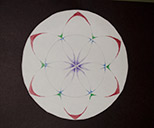Weaving in the Round
Explore color relationships using yarn through weaving on a prepared cd loom to create a concentric design.
SCHOOL: Grant Street Elementary
TEACHING ARTIST: Margie McDonald
GRADE LEVEL: K-6
Lesson: Students learn about the structure of woven material using a simple over and under weaving technique. Older students can make the loom on a repurposed cd while younger students will require a pre-prepared cd loom. Students explore and reflect upon color theory through discussion of yarn color choices and their impact.
Target Learning: Shows understanding of weaving using a cd disk loom.
Criteria: Creates the warp for a circular loom using a computer cd (older students) and weaves the weft into the warp over and under (younger students add the weft to a pre-prepared loom).
Target Learning: Combines yarn colors to show an understanding of color theory.
Criteria: Explains impact of color choices: warm or cool color palette for unity or warm and cool/complementary color combinations for contrast.
Target Learning: Uses craftsmanship in weaving techniques.
Criteria: Weaves evenly over and under and yarn tails are tucked out of sight.
Vocabulary (click here for the glossary)
color theory
complementary
concentric
contrasting
cool
cool color palette
loom
radiating
repurpose
reuse
unity
warm
warm color palette
warp
weave
weft
woven
Resources
Color wheel
Examples of fabric samples-woven versus knitted fabric
A prepared sample of paper strips to show how over and under weaving works
Mexican traditional 'Ojo de Dios' samples that show concentric circle weaving that students will be familiar with.
Materials
A repurposed cd: one per student
“Needles” cut from plastic containers
A collection of warm and cool color yarns cut to 6 ft.
Introduction:
What is weaving? Look at your clothing, is it woven or knitted? Notice and explain the difference of a weave with straight lines of cotton or knitting that stretches much more because it is made with loops that can straighten. Show a prepared example using contrasting warm and cool or complementary color in strips of paper demonstrating how an over and under weaving method holds together. Also show and discuss the unifying effects of using strictly a warm or cool color palette.
Lesson steps:
 Making Looms
Making Looms
Older students can make the warp by wrapping yarn on the cd, make sure the yarns are
an odd number, pay attention to laying the yarn neatly, not overlapping the yarns, make 13 or 15 wraps
and tie the ends together where they meet on the back of the cd. Each yarn warp piece should be approximately 6 ft long.
Cut weft yarns about 6 ft long, thread the plastic needle and leave the yarn double. Start
weaving over and under two or three times starting from the center, then carefully tuck the tail of the yarn through the hole in the middle of the cd and either tie it or just weave it over and under a couple of times on the back.
Continue to weave radiating or circling outward until the yarn is used up, cut the yarn off the needle and tuck the tail into the warp threads. When you choose your next color of yarn, consider the color scheme: do you want to use a warm and cool or complementary contrasting color combination? Or do you want to use all warm or all cool colors for a unified/harmonious color scheme?
Choose another color that creates contrast or has a unifying effect and start weaving again, this time leaving the tail to tuck under the last weaving. Don't pull too hard on the yarn.
You may embellish the cd weaving piece by securely adding beads or fringes.
Assessment: reflection questions.
Did you consider the finished effect of the concentric circles of color, and use a color scheme?
Did you weave evenly over and under?
Are the tails tucked out of sight?
What display method do you think would be more effective, hanging each piece on the wall
individually or putting them all together for a display?
What would that look like, with all those concentric circles of color put side by side like a quilt?
Could the arrangement of cd weavings for display reflect contrast or unity? How?
Learning Standards: Washington State Arts Standards: Component 1.1
GLE 1.1.6 Elements: Color: Warm/Cool, Complementary
GLE 1.1.7 Principles of Design: Contrast, Unity
GLE 1.2.1 Skills and Techniques: Weaving
